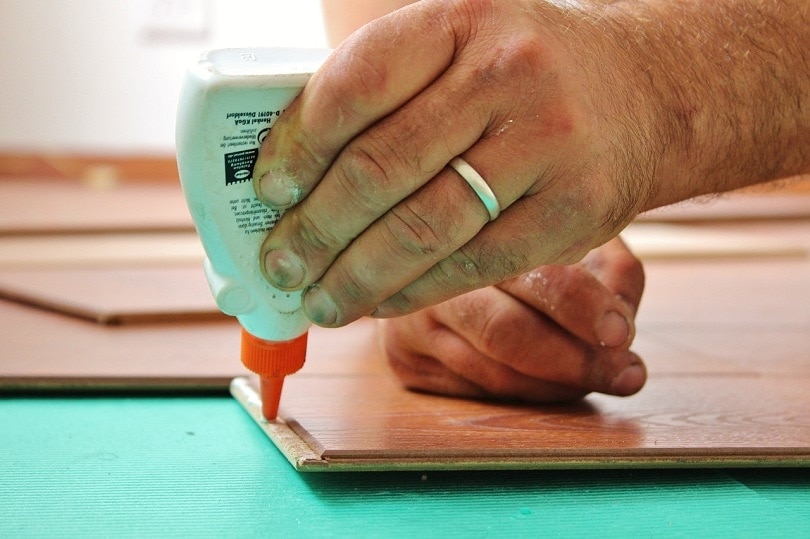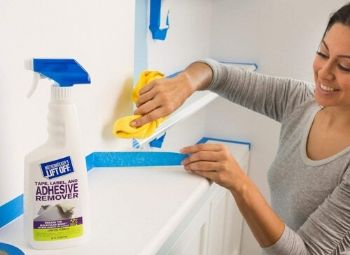How to Glue Paper to Wood: Step-by-Step Guide (with Pictures)
-

- Last updated:


Gluing paper to wood seems like a simple task, and it’s if you do it properly. If not, you may end up infuriated by the tiny bubbles or wrinkles that’ll pop up and give your project a less-than-desirable appearance. Fortunately, there are a few easy methods that you can employ to ensure a smooth, clean-looking finish.
Using Spray Adhesive
One of the easiest ways to glue paper to wood is to use a spray adhesive. It is a cheap and fast way to apply paper decals or decorations to your DIY projects. However, it can be less forgiving than other methods.
You must work very quickly as the adhesive dries rapidly, and there is more chance of misapplying the glue. If you apply it too thick, your paper can wrinkle and bubble. Using too little can cause your paper to curl or come off.
- Find a good adhesive: Choosing the correct adhesive for your project is very important. There are many types of spray glues available; however, some of them can be detrimental to your project. For example, foam or photo sprays will ruin the paper you’re gluing. Instead, you should use adhesives for artists or specifically designed for paper.
- Setup work area: Use a towel or a sheet to cover the work area. It is best to use an old towel that you don’t use anymore.
- Apply a thin coat of adhesive: That is all you need with spray adhesives. Applying a thicker coat will just slow the drying process.
- Allow adhesive to set: Wait for the adhesive to set for a much better bond.
- Press paper onto the wooden surface: Hold the paper by the corners and press it on the wood. Make sure to eliminate any bubbles as you push them to the sides.
- Allow to dry: Spray adhesives usually dry out after an hour. It is best to leave the wood flat instead of upright, to prevent the paper from sliding off.
Using Tacky Glue
Tacky glue is one of the better options to use in gluing paper to wood. Unlike regular glue that creates bubbles, tacky glue works with wood better because of its thick consistency. Its thickness allows it to stick to the wood more evenly and prevents the chances of air getting trapped and forming bubbles or wrinkles.
- Sand your wooden surface. Before applying tacky glue on the wood, sand the surface with a high-grit sandpaper and apply a polyurethane wood sealant. The smoother the wood surface is, the fewer bubbles that will form underneath the paper.
- Pour the tacky glue directly onto the wood. Don’t be scared to pour thick layers of glue, either. This is to ensure you have enough on the wood surface once you spread it throughout. Plus, you can always remove what you don’t need.
- Use a foam brush. Use a foam brush to spread the tacky glue over the wood surface. Ensure that it gets distributed evenly on the wood. Again, you can pour more tacky glue if needed.
- Paste your paper. When the wood is covered with even layers of glue, take your paper and line it up on the wood. Start with one edge of the wood and slowly work your way down. Once the paper completely covers the desired wood area, use your palm and run it across the paper. Press the paper from one edge to the other, making sure to get rid of any bubbles.
- Let the glue dry. Usually, it takes 1 hour for the tacky glue to adhere wood to paper. However, this will depend on the weather and ventilation of the area. You can always check after an hour if the glue has dried out. If not, wait for another hour, or if possible, leave it overnight.
Using a Mod Podge Formula
Mod Podge is best to use for arts and crafts. You can use it on nearly any type of surface, but it works best with wood and paper. What makes Mod Podge great is that it dries clear and holds tight. Mod Podge is also readily available in hardware stores and craft stores.
- Sand down rough areas. If you are using Mod Podge on wood, sand the wood surface first to ensure there are no splinters. Use medium-grit sandpaper to remove any rough areas.
- Gloss or matte Mod Podge. You can choose between a gloss or matte Mod Podge formula. Both are just as effective. It all depends if you want a shiny finish, which you will get from the gloss, or you can use the matte formula.
- Wet foam brush. Before soaking the foam brush in the Mod Podge, dip it in water. Then remove the excess water before dipping it into the Mod Podge. Make sure to get a good amount of glue before brushing it on the wood.
- Brush Mod Podge onto the wood. Use a back-and-forth motion when spreading the glue. Repeat the process until you’ve covered the entire surface.
- Press the paper. Press the paper on the wood with your palm. You can also use a Mod Podge applicator to ensure no bubbles form underneath the paper.
- Allow the Mod Podge to dry. This is a fast-drying glue, and it should be dry after 15 minutes.
Evenly Gluing Paper to Wood
We’ve discussed a few techniques for gluing paper on wood, and it can be quite simple if you utilize the proper techniques. Failure to do so can lead to unsightly bubbles, wrinkles, and tears. But when done correctly, you can end up with great-looking results that will last. Before using the glue, double-check the instructions for the drying time. Fast-drying formulas, like those used in spray adhesives, require you to work quickly.
See Also:
Featured Image Credit: Counselling, Pixabay
Contents


